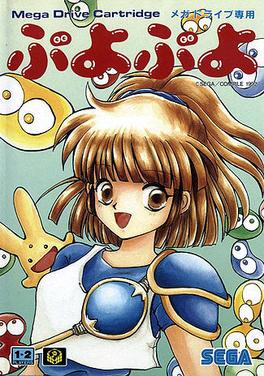
Puyo Puyo (ぷよぷよ) is a puzzle video game released in 1991 by Compile for the MSX2. Since its creation, it uses characters from Madō Monogatari. It was created by Masamitsu "Moo" Niitani, the founder of Compile, who was inspired by certain elements from the Tetris and Dr. Mario series of games.

Puyo Puyo~n, also known as Puyo Puyo 4 and Puyo Puyo~n Party, is a 1999 puzzle video game and the fourth installment of the Puyo Puyo series, created by Compile for the Dreamcast, PlayStation, Nintendo 64 and Game Boy Color. Like many of the Puyo Puyo games, it was never officially released outside Japan. The title of Puyo Puyo~n comes from the Japanese word yon, signifying the fourth game in the series.

Dr. Robotnik's Mean Bean Machine is a falling block puzzle game developed by Compile and published by Sega. It was released for the Sega Genesis / Mega Drive in North America and Europe in November 1993, and ported to the Game Gear in 1993 and Master System in 1994.
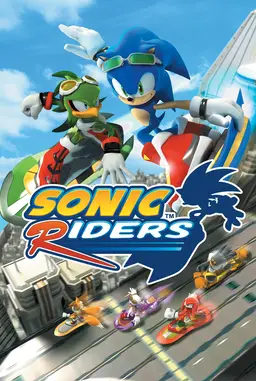
Sonic Riders is a racing video game developed by Sonic Team and Now Production and published by Sega for the GameCube, PlayStation 2, and Xbox. In the game, the player controls characters from the Sonic the Hedgehog series on hoverboards and competes against opponents—either controlled by computers or other players—in races and battles. The game was released in February 2006 in Japan and North America, with a European release following the next month and a Windows version at the end of the year. A Game Boy Advance version developed by Backbone Entertainment was canceled.
Compile Corporation was a Japanese video game developer, most notable for having developed the Puyo Puyo series, a franchise derived from the Madō Monogatari series. On 6 November 2003, the company shut down amid bankruptcy. As a result, key staff moved to Compile Heart, the company's spiritual successor, whereas shoot-'em-up staff moved to MileStone Inc.

Puyo Puyo 2 is a 1994 puzzle video game developed and published by Compile. It is the second installment in the Puyo Puyo series and the sequel to Puyo Puyo (1992).

Puyo Puyo Sun is the third installment of the Puyo Puyo games series, and the sequel to Puyo Puyo 2, made in 1996 by Compile. After the highly acclaimed success of its predecessor, Compile took a slightly more retro approach, so players had a more original feel to the game over that of 2.

Puyo Puyo! 15th Anniversary is a puzzle video game of the Puyo Puyo series, developed by Sonic Team and published by Sega for the Nintendo DS in 2006, as well as PlayStation 2, PlayStation Portable, and Wii in 2007. It has not been released outside of Japan for any consoles. This is the first Puyo Puyo game to be released on the Wii console.
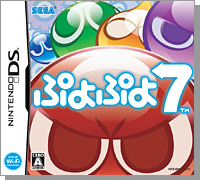
Puyo Puyo 7 is the seventh installment in the Puyo Puyo series, released in Japan for the Nintendo DS on July 30, 2009, and for the PlayStation Portable and Wii on November 26.

Puyo Puyo Box is a 2000 puzzle video game compilation developed by Compile for the PlayStation. It is Compile's last Puyo Puyo game before Sega, previously only owning the character rights, fully obtained the rights to the series. Puyo Puyo Box, being a compilation, primarily consists of earlier Puyo Puyo games, but also contains original content.

Puyo Pop, known as Minna de Puyo Puyo in Japan, is the first of the Puyo Puyo games made for the Game Boy Advance, and the first produced by Sonic Team. It is the last game to solely use the original Madō Monogatari cast, as later games would introduce many new characters to go alongside them.
Puyo Puyo (ぷよぷよ), previously known as Puyo Pop outside Japan, is a series of tile-matching video games created by Compile. Sega has owned the franchise since 1998, with games after 2001 being developed by Sonic Team. Puyo Puyo was created as a spin-off franchise to Madō Monogatari, a series of first-person dungeon crawler role-playing games by Compile from which the Puyo Puyo characters originated. The series has sold over 10 million copies, including the Madō Monogatari games.

Puyo Puyo!! 20th Anniversary is a puzzle game developed by Sonic Team and published by Sega. The game honored the twentieth year of the Puyo Puyo series, and was first released for the Nintendo DS in July 2011, and later for Wii, Nintendo 3DS, and PlayStation Portable in December.

Love Magic Fever is the 10th single from the Japanese idol group Idoling!!! and was released under the sub-unit name "Puyo Puyo Idoling!!!" (ぷよぷよアイドリング!!!). It reached number 10 on the Oricon weekly chart and sold 8,444 copies in the first week.

Puyo Puyo Tetris is a 2014 puzzle video game developed by Sonic Team and published by Sega. The game is a crossover between the Puyo Puyo series and the Tetris franchise, and features various gameplay modes incorporating both aspects. The game includes characters modeled and named after the seven Tetrominos, which are different puzzle pieces each made of four blocks.
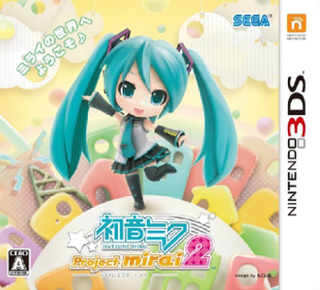
Hatsune Miku: Project Mirai 2 is a rhythm game created by Sega and Crypton Future Media for the Nintendo 3DS and the sequel to Hatsune Miku and Future Stars: Project Mirai. The game is also a spin-off of the Hatsune Miku: Project DIVA series of Vocaloid rhythm games and was first released only in Japan on November 28, 2013. Like the original, the game primarily makes use of Vocaloids, a series of singing synthesizer software and the songs created using these vocaloids most notably the virtual-diva Vocaloid Hatsune Miku. It is also the second game to include a Vocaloid made by Internet Co., Ltd., Gumi. An updated version of the game was released in 2015, first in Japan as Hatsune Miku: Project Mirai Deluxe, then in North America and Europe under the title of Hatsune Miku: Project Mirai DX.
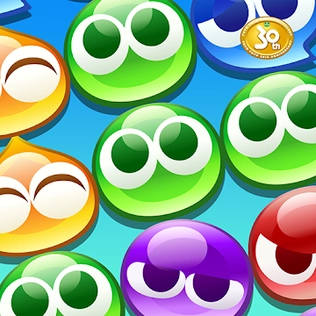
Puyopuyo!! Quest (ぷよぷよ!!クエスト) and Puyopuyo!! Quest Arcade, are two free-to-play puzzle role-playing video games developed and published by Sega for the iOS, Android, Kindle Fire and Arcade, released in Japan.

Puyo Puyo Chronicle is a 2016 puzzle video game developed and published by Sega for the Nintendo 3DS. It was released in Japan to celebrate the 25th anniversary of the Puyo Puyo series.

Puyo Puyo Champions, is a 2018 puzzle video game developed and published by Sega for the Nintendo Switch, Xbox One, PlayStation 4, and in 2019 for Microsoft Windows.

Puyo Puyo Tetris 2 is a puzzle video game developed and published by Sega. It is an installment in the Puyo Puyo series and a direct sequel to Puyo Puyo Tetris. The game was released for Nintendo Switch, PlayStation 4, PlayStation 5, Xbox One, and Xbox Series X/S on December 8, 2020 with a Windows version released on March 21, 2021. The game was released to generally positive reviews.

















